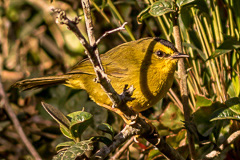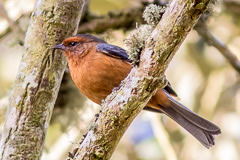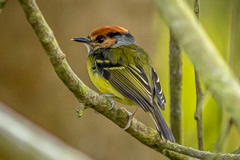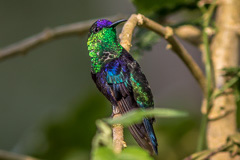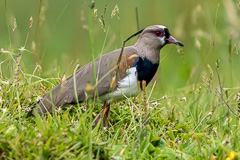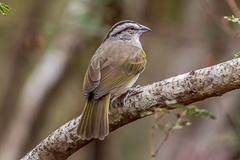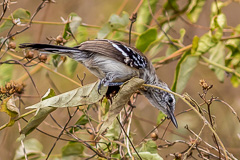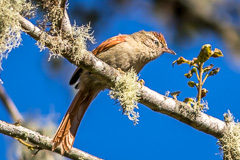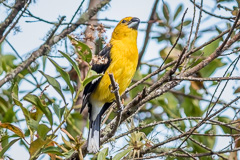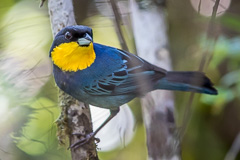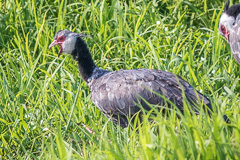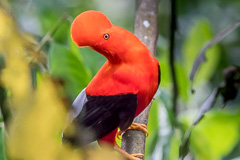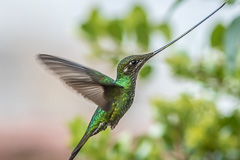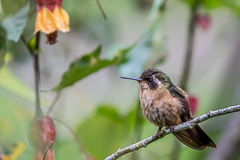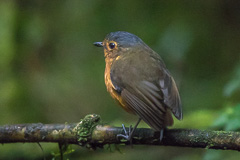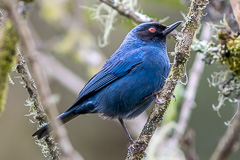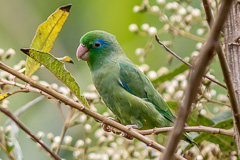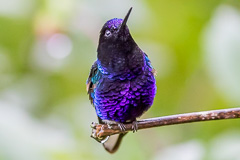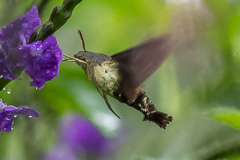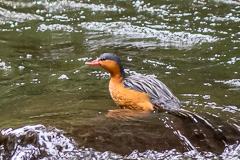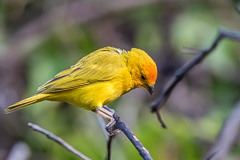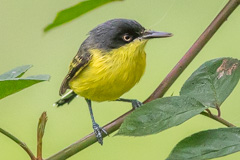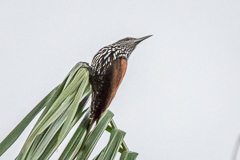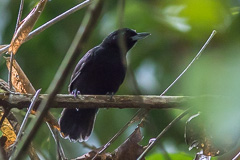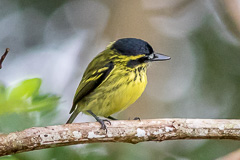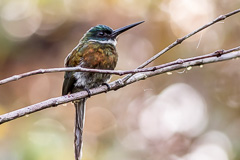Overview
Dates: |
1 - 28 March 2015. |
With Ian Harrison, Andrew Self and Ken Petersen. Although most of us had birded extensively in South America before, this was a first trip to Colombia for any of us. So the itinerary was based simply upon maximising the number of Colombian endemics and specialities, without any manic rushing between sites. Following recommendations from others, guiding and logistics were arranged with Pablo Flores of Multicolor Birding Colombia. The logistics worked well and Pablo was great to be with in the field. We would definitely recommend Multicolor Birding. As Pablo was not available the whole four weeks we birded a week using two of his local guides, José at Jardin and Jonnie in the western Andes. Ken also had an additional day guided by Trevor Ellery. Traveling around the country and security was smooth, although roads in the Andes were slow with drivers overtaking dangerously on blind curves. Colombia could never be described as a culinary destination, as most meals consist of the same choice of meat, rice, corn and/or banana, that becomes somewhat tedious after the third day. However, two items - soup and coffee - are exceptional and highly recommended. Most restaurants sold a hearty soup packed with vegetables and potatoes, that could easily constitute a full meal. Fresh coffee was available everywhere, and in four weeks we didn't actually encounter a single serving of Nescafé Instant - wonderful. Colombian beers on the other hand are decidedly weak and frequently didn't taste of anything remotely resembling beer. Aguila Light has to be the world's first beer to have no flavour at all!
Itinerary
Sofitel Hotel, Heathrow Chosen purely on the basis of being within walking distance of Terminal 5 for an early departure, the Sofitel is a standard, high priced business hotel. We booked in advance and though still fairly costly, was at a weekend rate, so we could live with the price. New, quiet and recommended for an early getaway. Free WiFi included. Casona del Patio, Bogotá The small Casona del Patio hotel is, depending on the time of day, a 20 minute to one hour drive from the airport. This is not a modern hotel, but rather a converted old residence that sells itself as a cheaper, travellers alternative. It is located in a quiet area, and had everything required for birders; a hot shower, free WiFi and a small restaurant, plus other restaurants within walking distance. Recommended. The main problem we encountered was the other guests. Noise insulation in this older building was not great and late night conversations in the patio area could be heard in most rooms. |
26-27 Feb. A lengthy journey from Chiang Mai via Bangkok and Amsterdam to join up with Ian at Heathrow. Due to our very early departure the following day we had to overnight there, and simply chose the most convenient hotel, the Sofitel, adjacent to Terminal 5. 28 Feb. Up stupidly early, in time to meet up with Andrew and take the British Airways 06:30 flight to Madrid. The two hour wait for the connecting Iberia flight to Bogotá was extended to almost three hours due to passengers not turning up at the gate, but the flight made good time and arrived on schedule at 16:00. Immigration queues fairly lengthy at Bogotá, but getting through immigration, customs and exchanging money proved to be pretty smooth. It was interesting to note that changing money requires a fingerprint in addition to a signature. That's a first anywhere at an airport. Pick up and transfer to the Casona del Patio in about 40 minutes due to the light traffic. Remarkably, the drive through Bogotá could have been any modern city. Almost devoid of birds save a few grackles and Great Thrush seen. |
Having now spent almost three days travelling was completely at the opposite side of the world from Thailand with a 12 hour time change, so feeling pretty dead.
1 Mar. Left Bogotá at 05:20 and drove to Chicaque Reserve. Being a Sunday, driving from the city was a straightforward and the whole drive took only an hour. Cold early on, and it took a while for the sun to warm up bird activity. A couple of hours produced the likes of Moustached Brushfinch, Rufous-browed Conebill, Golden-bellied Starfrontlet, Strong-billed Woodcreeper, Andean Pygmy Owl heard and Amethyst-throated Sunangel. We took breakfast at the reserve restaurant while staking out the hummingbird feeders, at which Glowing Puffleg and Collared Inca appeared. |
Mid morning we continued another half hour to the farmland and scattered forest patches around Pedro Palo lake. Weather very mixed for the rest of the day, varying from warm and bright to showers and overcast, though none of the changes seemed to affect bird parties of forest edge. The near endemic Indigo-capped Hummingbird was found rather easily peering into nearby gardens, but we failed to connect with the two other prime targets - Black Inca and Turquoise Dacnis. However, a constant flow of neat species included Green Hermit, White-vented Plumeleteer, Ash-browed Spinetail, Golden-faced Tyrannulet, Blue-capped Tanager, Flame-faced Tanager, Blue-necked Tanager, Golden Tanager and Rusty Flowerpiercer. Left around 17:30, with the return journey taking two hours with unexpectedly heavy traffic. Dinner at the nearby Wok restaurant, that servied a mix of Asian foods and was packed with locals and visitors alike.
2 Mar. Departed again at 05:20, only to find rush hour starts very soon after, and us encountering horrendous traffic, with the journey to Parque La Florida, on the perimeter of the city, taking over an hour. All along the entrance road to the park was a depressing mixture of garbage and dumped building material. Surprisingly, we arrived to find that the birding was actually inside the public golf course and a caddy cum guard had to accompany us on the course. Heading to the back of the course we were soon scanning the fast-disappearing reeds and sedges. A Solitary Sandpiper became the first migrant wader of the trip and common species included Yellow-hooded Blackbird and Bare-faced Ibis. It took a while to find our first speciality of the marsh, in the form of a pair of Subtropical Doradito, following which we heard, but could not locate Silvery-throated Spinetail. With some persistence and luck we eventually found Apolinar's Wren, and glimpsed one of the several vocal Bogota Rail. Despite the proximity of the airport, it still took best part of 40 minutes to drive there, from where we took the Avianca flight to Riohacha on the Caribbean coast. Here we were confronted with a massive change in temperature - hot, dry and very tropical. A short drive later and we were at the Barbacoa Hotel in town. |
A quick lunch and then out to the scrub in the Camarones area about 20 kilometres southwest of town. Although rather windy, the cloud was fairly extensive, so the temperatures very tolerable. Our strategy was to simple take any of the dirt tracks, drive slowly and stop when birds were found. A good list of species found including Tocuyo Sparrow, White-fringed Antwren, Trinidad Euphonia, Rufous-vented Chachalaca, Blue-crowned Parakeet, Sapphire-throated Hummingbird and Chestnut Piculet.
Barbacoa Hotel, Riohacha The small Barbacoa Hotel is located on a busy intersection in the middle of the city, so on the face of it does not look ideal. We were originally assigned a pokey room right at the front, right on the street. As this would likely be incredibly noisy we requested a room change and were given a much larger room on the inside of the building; so a considerable improvement. Nothing particularly wrong with this hotel but we would not give it a recommendation either. Only cold showers were available, but the hotel had a restaurant and free Wi-Fi. |
3 Mar. Another early start, and into the field at first light. A nice change to be away from the hectic roads of Bogotá, so it was a simple 30 minutes back to Camarones. Here we continued where we'd left off yesterday, with the cool conditions helping birding. In the morning we recorded Crested Bobwhite, Red-billed Emerald, Rufous-tailed Jacamar, Russet-throated Puffbird, White-whiskered Spinetail and Slender-billed Inezia among a fair number of others. Probably our biggest miss was Buffy Hummingbird, that was likely due to the very dry conditions and lack of flowering plants. Around 11:00 we entered the Los Flamencos Sanctuary, and took a walk around the first part of the lagoon. A large array of waterbirds included Roseate Spoonbill, Scarlet Ibis, Willet, Reddish Egret, Spotted Sandpiper and Royal Tern. Following a fresh seafood lunch on the beach we headed west toward Santa Marta, stopping at a couple of forest patches en route, at El Bosque and the Palamino River. At El Bosque a short walk to the river gave Black-headed Tody Flycatcher, Baltimore Oriole and three flyover Military Macaw. A longer stop at Palamino was very productive, with White-bellied Antbird, White-bearded Manakin, Cinereous Becard, Rufous-and-white Wren, Blue Dacnis and Prothonotary Warbler. A two hour drive to Minca, at the base of the Santa Marta mountains, arriving just after dark. Unfortunately, across the river from our accommodation, at Sierra's Sound, a noisy party was in full swing with the noise continuing till past 23:00.
4 Mar. Started the day with a drive back down the mountain to Santa Marta, turned south and headed out of town as far as the new port road. The main target here, Chestnut-winged Chachalaca, was found rather easily, as well as Ruby-topaz Hummingbird, Forest Elaenia and Sapphire-throated Hummingbird. Continued along the coast as far as Salamanca National Park, where an hour or so around the headquarters and short mangrove boardwalk produced Golden-green Woodpecker, Yellow-chinned Spinetail and Black-crested Antshrike - the form here looking very different and restricted to mangroves, so a likely future split. During another short stop in field edges we found a couple of Sapphire-bellied Hummingbird and Stripe-backed Wren. A final roadside stop produced the highly restricted Bronze-brown Cowbird. A two hour drive back to Minca, and lunch at the Minca Hotel, where the hummingbird feeders attracted at least 40 hummingbirds of eight species, including Pale-bellied Hermit, White-necked Jacobin and Steely-vented Hummingbird. Once the heat of the day had abated we continued up the mountain toward the ProAves El Dorado Reserve. Deteriorating road conditions ensured the need for our high clearance vehicle. A couple of stops en route late afternoon produced our first endemics - Santa Marta Brushfinch, Santa Marta Tapaculo, Santa Marta Blossomcrown and Santa Marta Antbird. Stopped for Santa Marta Screech Owl just after dark before arriving at the lodge around 19:00. Here we ran into three other birding groups - February and March being peak time for visiting birders to Colombia.
Sierra's Sound, Minca This small accommodation is situated on the outskirts of Minca by the small river flowing through town. Simple and quiet with comfortable rooms. Showers allegedly hot, but some iffy shower units meant that not everyone had one. Internet was working the first night but absent the second night, and seemingly depends on the owner being present. Standard dinner and breakfast options were available. Recommended. ProAves El Dorado This very comfortable lodge, owned and operated by ProAves has been operational since 2011. No phone coverage, but slow internet was working. Great food, especially the soups prepared by the local staff. Rooms with hot showers. The garden was decked out with hummingbird feeders with at least eight species visiting. Highly recommended, though not cheap. Staying at El Dorado is realistically the only option for birders wishing to bird the upper altitudes of Santa Marta early morning. The alternative, to stay in Minca, requires a two hour plus journey each way. |
5 Mar. A very early start at 04:30, in order to drive to the upper section of road beyond El Dorado, that terminates at a military camp and telecommunications towers at 2,600 metres altitude, for dawn. This road is in seriously poor condition and it's noticeable that all vehicles going up are good 4x4s with jacked-up suspensions. The short drive took over an hour, with our first bird a calling Santa Marta Screech Owl. Next up, in the early gloom, were Santa Marta Antpitta and Slaty-backed Nightingale-Thrush on the track. All morning spent at these upper reaches with a series of Santa Marta endemics seen or heard. Much time was spent trying to see Sierra Nevada Antpitta and Brown-rumped Tapaculo, with only the former seen. A couple of stops en route back to the lodge were productive, with Andean Condor, White-tipped Quetzal, White-lored Warbler, Cinnamon Flycatcher and several more Brown-rumped Tapaculo heard only. All afternoon spent in the garden of El Dorado Lodge, concentrating on the hummingbird feeders. Among the many hummingbirds, we had success in finding White-tailed Starfrontlet, Lazuline Sabrewing and Black-backed Thornbill, but failed to find Santa Marta Woodstar. A group of Black-fronted Wood Quail, that regularly visit the lodge compost heap, was a nice bonus.
6 Mar. A veritable lie-in, with breakfast at 05:20. From the lodge we drove about 30 minutes uphill to start roadside birding at a little over 2,000 metres. Santa Marta Parakeet frustratingly heard only, but this time we did connect with Brown-rumped Tapaculo as well as adding several new species to the list such as Black-throated Tody Tyrant, Golden Grosbeak, Black-breasted Jay, Mountain Velvetbreast and Flammulated Treehunter. Most of the morning was spent unsuccessfully trying to find Santa Marta Parakeet, but it remained totally elusive. Lunch back at the lodge, followed by another couple of hours searching for Santa Marta Woodstar in the gardens and at the feeders, but no luck. Started our drive downhill, stopping at Pedro Alto, seeing Santa Marta Blossomcrown again but not the woodstar as reported from there in the morning. Other birding in the area produced Santa Marta Tapaculo, Grey-throated Leaftosser and Groove-billed Toucanet. Stayed at the garden till 18:00 then drove to Minca with overnight at Sierra's Sound again.
7 Mar. With our not having had time to bird mid-elevation areas previously we started with a 40 minute drive reascending the road toward El Dorado, where we birded an area of scrub and coffee shade forest for three hours. The main target, Santa Marta Foliage-gleaner was heard several times before this skulking species finally showed itself. Other birds of interest included Spectacled Tyrannulet, Chestnut-crowned Warbler and a tiny hummingbird zipping past, that was probably Santa Marta Woodstar and an excellent dip! A 90 minute drive to the airport of Santa Marta, to catch the 11:45 flight to Medellin. Here we suffered a minor delay in proceedings as our driver, Juan, had been rear-ended en route to the airport and subsequently had to deal with police and insurance issues. We eventually got underway around 14:30, heading to the Chestnut-capped Piha Reserve. During a short birding stop late in the day we found Tody Motmot and Colombian Chachalaca. A final stop after dark to try for Lyre-tailed Nightjar was unsuccessful.
ProAves Piha Reserve Another recently opened lodge in Antioquia. As this reserve receives far fewer visitors than the more famous El Dorado the accommodation is simple, but effective, with six rooms. Electricity is 24 hours with good hot showers, but no Internet or mobile signal. Food once again very good and hummingbird feeders in the garden make for relaxing viewing and photography. The reserve and lodge are run by a single couple - the ranger and his wife - and they make an impressive job of it. We really enjoyed this pleasant place. Very comfortable, great atmosphere and it would have been nice to have stayed longer. |
8 Mar. All day walking the roads and trails around the reserve. Left the lodge at 05:45 to overcast skies that were looking distinctly like rain. We first headed up the Principal Trail veering right onto the Waterfall Trail, where the first few spots of rain began, though luckily dissipating as fast as they appeared. In the low humid gullies we had Stiles's Tapaculo, Chestnut-crowned Gnateater, Green-fronted Lancebill and White-throated Spadebill. For the remainder of the morning we headed slowly up the Principal Trail to the ridge, finding a string of impressive species such as Scarlet-and-white Tanager, Black Hawk-Eagle, Moustached Puffbird, Red-faced Spinetail and Rufous-naped Greenlet. Lunch at the top was kindly bought up by the ranger - what incredible service and consideration. Post lunch, in the heat, we birded the open ridge, where despite the sun, the birding was excellent with Chestnut-capped Piha, Multicoloured Tanager, Purplish-mantled Tanager and Indigo Flowerpiercer. Arrived back at the lodge around 17:15 just in time for the final feeding frenzy at the hummingbird feeders - Purple-throated Woodstar, White-necked Jacobin, Andean Emerald, Green-crowned Brilliant, Green-crowned Woodnymph and Steely-vented Hummingbird. After dark a Tropical Screech Owl was vocal, and seen poorly, in the garden.
9 Mar. Our vehicle and Juan, the usual F1 driver wanna-be, arrived early morning. Having packed the vehicle, we left the Piha Reserve early to try to find Parker's Antbird, that we'd missed yesterday.
This proved somewhat tricky, and it wasn't until we were almost leaving the area that we finally obtained reasonable views of this supposedly common bird. Black-headed Brushfinch was also a nice addition to the list. We made several stops as we descended into the lowlands, especially around El Tabon, with White-mantled Barbet, Sooty Ant Tanager and Yellow-browed Shrike-Vireo. A lengthy drive to Rio Claro with a short stop en route near Puerto Barrio where, despite massive disturbance from construction of dual carriageways, we had several Northern Screamer, plus Black-collared Hawk and Yellow-chinned Spinetail. Overnight inside the Rio Claro Refuge with a hot and humid night and heavy rain. |
10 Mar. Started pre-dawn with coffee on the roof of the accommodation. A number of calling birds, but little activity actually seen other than Red-rumped Woodpecker and Bright-rumped Attila
At dawn we birded the entrance road for a couple of hours finding Grey-cheeked Nunlet, White-tailed Trogon and Chestnut-backed Antbird, followed by a walk along the river searching for Magdalena Antbird, successfully found. Breakfast at the refuge restaurant at 08:00, after which the day had already become noticeably hot. We birded one of the local trails picking up Antioquia Bristle Tyrant, Bay Wren, Pacific Antwren, Cocoa Woodcreeper, Scarlet-browed Tanager and Orange-crowned Oriole. Lunch and a welcome siesta till 14:30 when we headed out of the refuge to bird nearby forest edge. This was good for Striolated Manakin and Southern Bentbill, but temperatures were still high, with little activity, though an earthquake, centred 100 kilometres north of Bogotá, certainly shook up the afternoon. The final couple of hours found us walking to the Condor Cave where several pairs of Oilbird were present. A final scan of treelines in the area failed to find the scarce Blue Cotinga. |
Rio Claro Refuge When birding Rio Claro the options are to stay in a hotel in town or inside the refuge. We chose the later. It's great to be on location early morning, but this place is decidedly different. Hot and humid, with no mosquito nets (though in truth these are not really required), but no fan and no mesh on the windows. The later means that having on the lights fills the rooms with a fantastic assortment of bugs and geckos. Great if studying insects. Cold showers only. A simple restaurant serves a limited selection. Would we stay here again? Yes, due to the location, but be prepared for the heat and humidity. According to the management, fans and A/C are not provided as not environmentally friendly. Fair enough, but they use only plastic disposable cups in the restaurant. Go figure that one. |
11 Mar. Dry overnight, so with clear skies the temperatures had dropped to something pleasant early morning. Suprisingly however, that didn't translate into better bird activity and an hour's wander at dawn along the entrance road was extremely quiet. So quiet, that we decided to cut our losses, leave Rio Claro and head toward Jardin earlier than planned. At a first stop en route we put in quite some effort for Bare-crowned Antbird and Beautiful Woodpecker but to no avail. Continued to the Cocorna area where in the heat of the day we eventually found, with a lot of persistence from Pablo, a pair of Beautiful Woodpecker - that is indeed a stunning bird. Drove, in heavy traffic, to Medellin and dropped Pablo, before completing the journey to Jardin where we arrived just before dark. It has to be said, that driving in Colombia, particularly on Andean roads, is a hair-rasing experience. Deaths from overtaking on blind curves must be seriously high. Dinner in town, with its attractive square dominated by its church.
La Casona Hotel, Jardin Jardin, a pleasant though noisy, town has the La Casona Hotel situated right at the centre. The layout of the hotel, around a central meeting area, means that talking guests can keep everyone awake. Added to that, the nearby church bells toll every 15 minutes and can clearly be heard. Otherwise small and comfortable. Mediocre showers, but good food options available in the town square. |
12 Mar. Met up with José, our local guide, for another 05:00 start in order to drive to Yellow-eared Parrot stakeout pre-dawn. Yet another bird tour was already there and waiting when we arrived. It's critical to get here before light, as the parrots roost nearby and can only reliably be seen when flying from their roosts to whichever feeding areas they current use. In the first 20 minutes we had several groups, totaling about 40 birds.
Also a lone Rufous-bellied Nighthawk was patrolling early on. A subsequent, short, walk in the area gave us Black-billed Mountain Toucan and poor views of a very shy Blackish Tapaculo. Breakfast at the farmhouse of one of the farmers involved in the preservation of the parrot, with the adjacent hummingbird feeders attracting both Sword-billed Hummingbird and Buff-tailed Coronet. The remainder of the day was spent slowly walking downhill through various altitudes, finding an incredible selection of species, and we finished the day with well over 100 species. Late afternoon returned to Jardin to visit the Andean Cock-of-the-rock lek with several displaying birds very close. A repeat dinner in the town square. |
13 Mar. Arrived at the Sirififi River early hunting three targets - Antioquia Wren, Greyish Piculet and Apical Flycatcher. A very noisy site, close by the main road with heavy traffic, stone crushers working in the river and a deafening cicada chorus. Inside two hours Antioquia Wren and Greyish Piculet were easily found, but it took a lot of searching to convince ourselves we had Apical Flycatcher with good views of the pale tip to the tail. Moustached Barbet also found. Said goodbye to José and drove four hours to Manizales where we picked up Jonnie, our guide for the western Andes. Our initial foray was into the watershed above town, where their feeders produced White-bellied Woodstar, White-throated Daggerbill, Long-tailed Sylph and Fawn breasted Brilliant. A walk in overcast conditions added Ocellated Tapaculo plus several other antpitta and tapaculo species heard. Around 17.00 rain set.
14 Mar. Unfortunately, due to a starting problem, Juan and our usual vehicle didn't turn up at 05:00, but thankfully another vehicle and driver had already been requisitioned. So proceeded back to Rio Blanco for some owling, with White-throated Screech Owl found. We walked the area around the visitor centre first, but very cool with little bird activity. After breakfast at the visitor centre we spent all morning birding with the warden whilst he performed his daily round of feeding the antpittas - amazing to see these skulking birds so accustomed to humans. We encountered a couple of large flocks with the likes of Tyrannine Woodcreeper, Sepia-brown Wren, Capped Conebill, Black-eared Hemispingus and Rufous Wren and well as finding Ash-coloured Tapaculo and Spillmann's Tapaculo. After lunch at the visitor centre we walked downhill but the low light combined with overcast and cool conditions made the birding difficult. Only Rusty-faced Parrot added to the list. Not to be defeated, and in some perverse logic, we headed higher up the mountain in an effort to get above the rain. However, showers and low cloud made conditions miserable and largely birdless. Still, we tried. 15 Mar. Drove up to Paramo del Ruiz, our coldest and highest day of the trip, where the temperature at 4,100 metres was a balmy 2°C. We started with the highest altitude specialities in the form of Buffy Helmetcrest, Andean Tit-Spintetail and White-chinned Thistletail. A lonesome Brazilian Rabbit was also seen around the visitor centre. |
Flushed with early success we back-tracked to Laguna Negra for Many-striped Canastero and Andean Teal, followed by coffee and breakfast at a small café at the top. Being a Sunday, a number of visitors were out and about, many trying to be macho and hard in lycra shorts and T-shirts. Much of the remainder of the day was spent birding the road down toward Termales, and at the feeders of del Ruiz Hotel. Quite slow, but one good flock found with Black-backed Bush Tanager, Blue-backed Conebill and Black-eared Hemispingus. Amazingly, by mid afternoon still no rain, although we lost visibility at lower levels due to cloud, so returned to the top, passing through hail and sleet, to clear weather above the cloud. Although staying until 18:00 we saw little other than a larger group of Black-backed Bush Tanager. Overnight in Manizales town.
Hotel Estelar Conference Centre, Manizales Manizales is a sizeable city, so this accommodation was chosen as it lies on the quieter, outskirts of the city with access to the birding areas without crossing the city. Sterile would be best adjective to describe it. The rooms were rather small as a twin, but the facilities were good and worked, though the WiFi was rather slow. A typical conference/business hotel. A visiting football team were staying overnight on our first night, and the second night a huge party and disco at the far end of the complex was going till early morning, so not exactly as quiet as anticipated! |
16 Mar. Overnight rain continuing into the morning, so it was grey and overcast when we left at 05:00 to Apia. Unfortunately the drive took longer than expected as we were involved in an accident that we were not actually involved it. On passing through Pereira city on a wet road the motorcycle ahead clipped a road cone, which was sent spinning across our carriageway. Instinctively Juan placed on the warning lights and slowed, fearing sending the cone flying elsewhere. Unfortunately the motorcyclist behind, a young schoolgirl, was not so observant and tried to swerve out of the way resulting in coming off on the wet road. And all of this happening in front of about 20 traffic police. It was very impressive that an ambulance and a fire engine arrived within three minutes. Contrast that with Thailand when you will lie bleeding to death in the road while the police paint lines around you trying to figure out who was responsible. Very fortunately no serious injury, and the police let us depart having seen Juan was not directly at fault.
Eventually we arrived at Apia at 08:20, collected our local guide and headed up to the local reserve cum park cum eco-tourist initiative, that is attempting to achieve a balance between farming and eco-tourism in en effort to protect habitat and species. Breakfast at a family farm, then to the forest where we heard several Yellow-headed Brushfinch, but took a while to actually get views of one of them. Continued walking inside the forest searching for the area's other speciality - Yellow-headed Manikin. It took even longer for us all to obtain views of this unobtrusive bird, habitually alighting briefly then disappearing again. Golden-breasted Fruiteater also seen well. Having left the area, we transferred a few kilometres down the valley in search of Viridian Dacnis, that was not found, so had to make do with Red-faced Spinetail and Greyish Piculet. Completed the drive to Tatama National Park to arrive at Montezuma Lodge around 15.00. As expected in this very wet Choco region, that receives around 10 metres of rainfall annually, it was foggy and raining, so we simply hung around the lodge watching the hummingbirds at the feeders. An impressive 15 species found, giving excellent photo opportunities, including stunners such as Purple-bibbed Whitetip, Velvet-purple Coronet, Empress Brilliant and Rufous-gaped Hillstar. |
Montezuma Lodge, Tatama National Park Given the locality, you'd not want to stay anywhere else. Right on the forest edge and run as an eco-lodge. A great place. Basic but comfortable. New rooms were under construction. Warm showers, no WiFi, mobile signal only from the lodge and food fine. Very helpful staff. Laundry was possible but drying took three days in the almost constantly damp conditions. Given the weather we experienced and the birds we missed we'll be back. |
17 Mar. The pre-dawn drive to the top, at 2,500 metres took about 1 hour 15 minutes. Given that the distance was probably around 12 kilometres showed how appalling the track is. We'd already swapped our 4x4 Mitsubishi Pajero for a serious off-road vehicle to do this drive. One of the roughest roads any of us could remember. It took a while to obtain good views of the endemic Chestnut-bellied Flowerpiercer and Munchique Wood Wren. Then breakfast with the soldiers regarding us as entertainment for the troops. We spent the morning slowly descending and birding various elevations, but the birding was inexplicably slow. Incredibly this mountain has between 400 to 500 species recorded, although to us today it felt more like 40-50. The pick of the species had been Rufous browed Chlorophonia, Brown Inca on a nest, Rufous Spinetail and Dusky Chlorospingus. Lunch in the field was kindly delivered by motorcycle from the lodge. Low cloud and rain showers started at 12:30, resulting in bird activity dropping from low to zero - the afternoon became a hard slog with a few specialities coming slowly - Black-chinned Mountain Tanager, Gold-ringed Tanager, Black-and-gold Tanager and Rufous-throated Tanager. Fog continued to be very frustrating with any bird in the treetops various called unicoloured tanager or cloud-forest hemispingus. Continuous rain started at 16:45 when we gave up and returned to the accommodation.
18 Mar. Overcast but no overnight rain. As we didn't have to actually return to the summit area we left slightly later at 05:25, driving up about eight kilometres to 2,000 metres altitude. At dawn, whilst breakfasting, the skies still looked rather foreboding, so it didn't take long before the reality arrived and we were confined to the vehicle for an hour sheltering from the downpour. Eventually started walking downhill to improving weather. With the fog lifting the bird activity improved with several key species putting in an appearance; Star-chested Treerunner, Beautiful Jay heard, Northern Chestnut-breasted Wren, Yellow-breasted Antpitta, Flame-faced Tanager, Uniform Treehunter and Bicoloured Antvireo. Walked about five kilometres until about 12.30 when lunch arrived and heavy rain started, so again an hour in the vehicle. We'd walked back almost to the lodge by 16.15 when heavy rain really started. With the continuing rain the creek running past the accommodation was an impressive torrent, which looked like it could take the bridge away.
19 Mar. A lay in till 05:40 when the plan was to return uphill three kilometres to work lower areas. Well that was the plan, but rain most of the night, was still falling heavy in the morning, meaning we simply hung out by the lodge feeders waiting for it to stop. Clearly it didn't want to, so at 10:00 we left early for the drive to Otún Quimbaya, arriving around 15:00 dropping off Jonnie en route. That left us with a couple of hours birding on our own, with us recording Tyrannine Woodcreeper, Cauca Guan and Red-ruffed Fruitcrow. Overnight at the Otún Quimbaya Training Centre lodge with damp and cold weather probably the coldest we'd felt at 2,000 metres on this trip. |
Otún Quimbaya Training Centre This sizeable lodge just inside the Otún Quimbaya Reserve runs as a training centre for park staff and other groups. The place has a feeling of university and school dinners about it, as meal times are fixed and you queue up in front of the servers. When was the last time any of us did that? The rooms were fine with hot showers. No internet. Virrey Park, Bogotá A tourist/business hotel in an upmarket area of town. Good accommodation, quiet with all facilities. |
20 Mar. Met up again with Pablo and repeated the walk of yesterday afternoon. Weather cool and partly cloudy but bird activity good. At dawn while owling, we had Crab-eating Fox and Lemurine Night Monkey but failed to see Colombian Screech Owl. Much time spent looking for Moustached Antpitta that remained very well hidden but vocal. Other birds in our morning included White-capped Tanager, Wattled Guan, White-capped Dipper and Torrent Duck - the latter a surprise. Left at 12:00 for drive to Pereira airport, 45 minutes away. A short 35 minute flight to Bogotá then overnight at the Virrey Park as a double booking at the Casona del Patio prevented our return there. |
21 Mar. Ken finally joined us, arriving at some unholy hour after midnight, just in time to rise again for our 05:00 start to the paramo at Guasca. Breakfast at the only functioning café in town and then onto the paramo proper around 3,400 metres altitude. Superb weather and excellent birding with White-bellied woodstar, Glossy Flowerpiercer, Black Flowerpiercer, White-sided Flowerpiercer, Bluish Flowerpiercer, Coppery-bellied Puffleg and Black-chested Mountain Tanager. Moving higher, over the pass to forest on the other side we had Flame-winged Parakeet, a really close Tawny-breasted Tinamou that refused to be seen, Pale-bellied Tapaculo and Golden-crowned Tanager. To finish the day we drove back to the other side of Guasca for Bogotá Rail, where we also had several other species new for the trip such as Little Blue Heron, Eastern Meadowlark, Grassland Yellow Finch and Noble Snipe.
22 Mar. A one hour drive, out of town, to the Enchanted Garden where hummingbird feeding has been ongoing for something like 25 years. A dazzling array of hummingbirds at the feeders manage to consume around 200 kilos of sugar a month. A nice selection of species, although only Gorgeted Woodstar was an addition to the trip list. The scarce Indigo-capped Hummingbird was present. By 09:00 we had to depart to the airport to check in for our flight to Mitú. After a one hour flight we arrived into this remote region near the Brazil border. Flying in, it was delightful to see hundreds of square kilometres of apparently intact rainforest. |
The omens felt good, although the hot steamy conditions on arrival didn't feel so. Onward to the Hotel Los Paisas in this rather small, cozy town with a decidedly frontier feeling.
Hotel Los Paisas Considering the remote location, the standard of accommodation at Mitú is very good. Of several places in town, the Hotel Los Paisas is probably the best. Clean and spacious rooms with fridge even. Cold showers only. The town has 24 hour electricity, but Internet is only available as a free WiFi connection in the town square. As the whole town uses this only connection it was so slow as to be unusable. It was relaxing to be cut off from the rest of the world while enjoying the excellent birding in the area. |
Transport options are limited in Mitú, so this afternoon we were out with our very dilapidated Landrover. Fortunately, there are few roads and not many kilometres of them. Spent the afternoon at a very hot Cerro Uranus and a later walk along the main access track, with Plumbeous Kite, Yellow-browed Sparrow, Red-fan Parrot, Azure-naped Jay, White-necked Jacobin, Green Oropendola, Green-tailed Goldenthroat and Versicoloured Emerald to name just a few.
23 Mar. Due to being so far east in Colombia, sunrise comes early to Mitú, so a very early start at 04:30 with a 45 minute drive to Pueblo Nuevo where we picked up Miguel, our native Indian guide, and took a trail behind the village into terra firma forest. Reddish-winged Bare-eye, Fiery Topaz, Reddish Hermit, Pavonine Quetzal, Paradise Jacamar, Little Woodpecker, Collared Puffbird, Chestnut-belted Gnateater and Yellow-throated Woodpecker. Met one unpleasant guy at the river who reckoned this trail was his forest trail and we should pay him, rather than the village chief whom we'd already paid. Talk about trying it on. Back to the vehicle by 15:30 just before rain started at 15:45 when we returned to town.
The last hour of light spent at the start of the trail leading into white sand forest from Mitú Cachivera, where we met our next local guide, Agapino, from a different tribe. Complicated access logistics to sort out at Mitú! 24 Mar. An 05:00 start to white sand forest with Agapino. Extremely quiet, or rather very low species density in this habitat, so we managed to walk right through the forest seeing none of the specialities. Inside the terra firma forest was better, with Pompadour Cotinga. We also found a small ant swarm with a supporting cast of Chestnut-crested Antbird, White-browed Antbird and Bicoloured Antbird. No ground cuckoos of course, that remain a near myth! The return walk during the afternoon was more productive, with Grey-bellied Antbird and Saffron-crested Tyrant-Manakin. A lot of walking today, so some very tired feet by the end. Very welcome beers and dinner. 25 Mar. A 40 minute drive to Ciema track, where we walked through a mixture of white sand and terra firma forest. Pale-tailed Barbtail, Yellow-billed Jacamar, Orinoco Piculet, Paradise Tanager, Opal-crowned Tanager, Dusky-throated Antshrike, Black Bushbird and Guianan Cock-of-the-rock were just some of the fantastic collection of birds we encountered. Back for lunch in town, where luck had it, it just started to rain. A short siesta then back to the same area as yesterday around Mitú Cachivera, taking another trail through cultivation and forest edge, with Yellow-bellied Dacnis, Citron-bellied Attila, Amazonian Umbrellabird and Black-bellied Thorntail. Rain stopped play at 17:30, but we just had time for a last minute stop outside town for the splendid Point-tailed Palmcreeper. 26 Mar. A tough, long day with 14 hours in the field, starting at 04:30 when we drove to the Santa Cruz road. The day started exceedingly well with Ringed Antpipit and Banded Antbird. However, it went downhill rapidly thereafter, though not from lack of trying. For the next six hours we trudged around trails in the heat barely finding a single bird. Around 16:00, when it finally cooled and after much effort, we found Tawny-tufted Toucanet and Brown-banded Puffbird - excellently picked out by Agapino, when just about everyone else was thinking about quietly sleeping in the heat! Late afternoon we walked the road till 17:30 finding Magpie Tanager new for the trip plus another Black-bellied Thorntail. Late arrival back at the hotel. 27 Mar. Another return to Mitú Cachivera, with us persevering with white sand forest and trying a different trail. A Collared Gnatwren played very hard to get, but Bronzy Jacamar, Spotted Puffbird, Red-necked Woodpecker and Rufous-tailed Xenops proved easier. We got caught out in heavy rain mid afternoon. Late afternoon by the village and river hoping for a flyover Amazonian Umbrellabird, but found Amazonian Inezia instead. |
28 Mar. Our final morning, with an early boat ride to Santa Marta, finding Greater Yellow-headed Vulture, Muscovy Duck, Spotted Sandpiper, Black Caracara, Scarlet Macaw and Dusky-throated Antbird. A short walk in the forest behind the village produced Moustached Antwren, Cherrie's Antwren, Bronzy Jacamar and Chestnut-capped Puffbird. With reluctance we had to leave late morning to catch the flight to Bogotá. A great way to end the trip. Overnight at Casona del Patio again. Celebratory meal at the Wok again.
29 Mar. Sadly, flights home. A fantastic trip and a wonderful experience. Over 850 species, good weather and great company. We'll definitely be back!
Galleries
Bird images from this, and other, birding trips.
Travel images from this, and other, birding trips.

